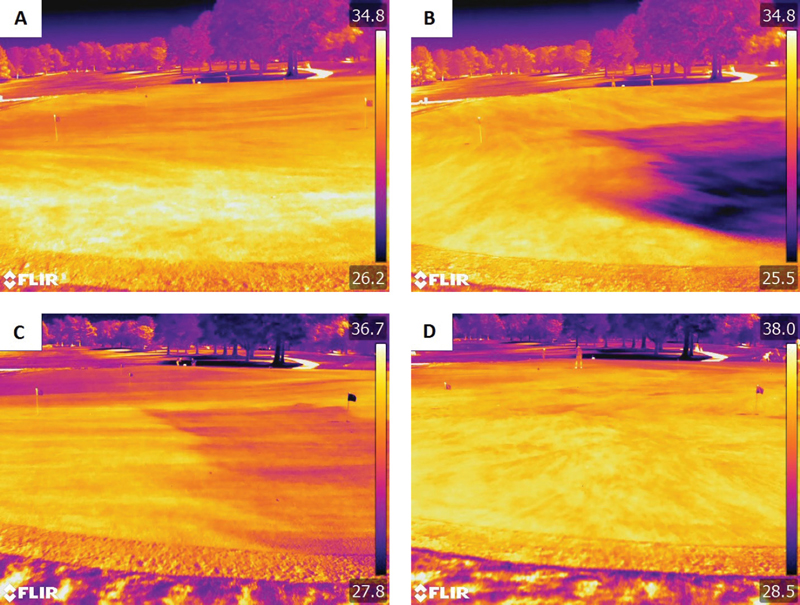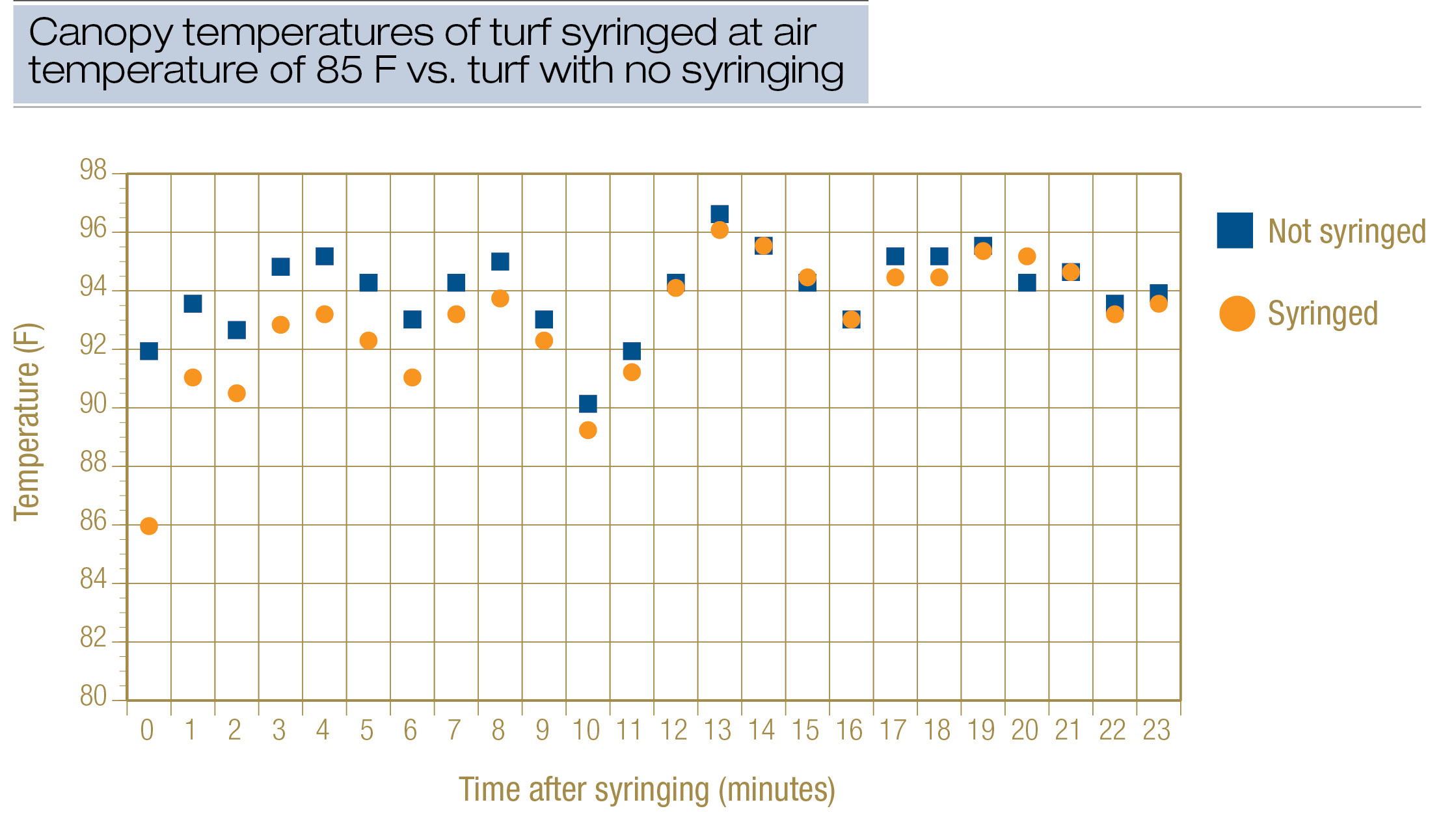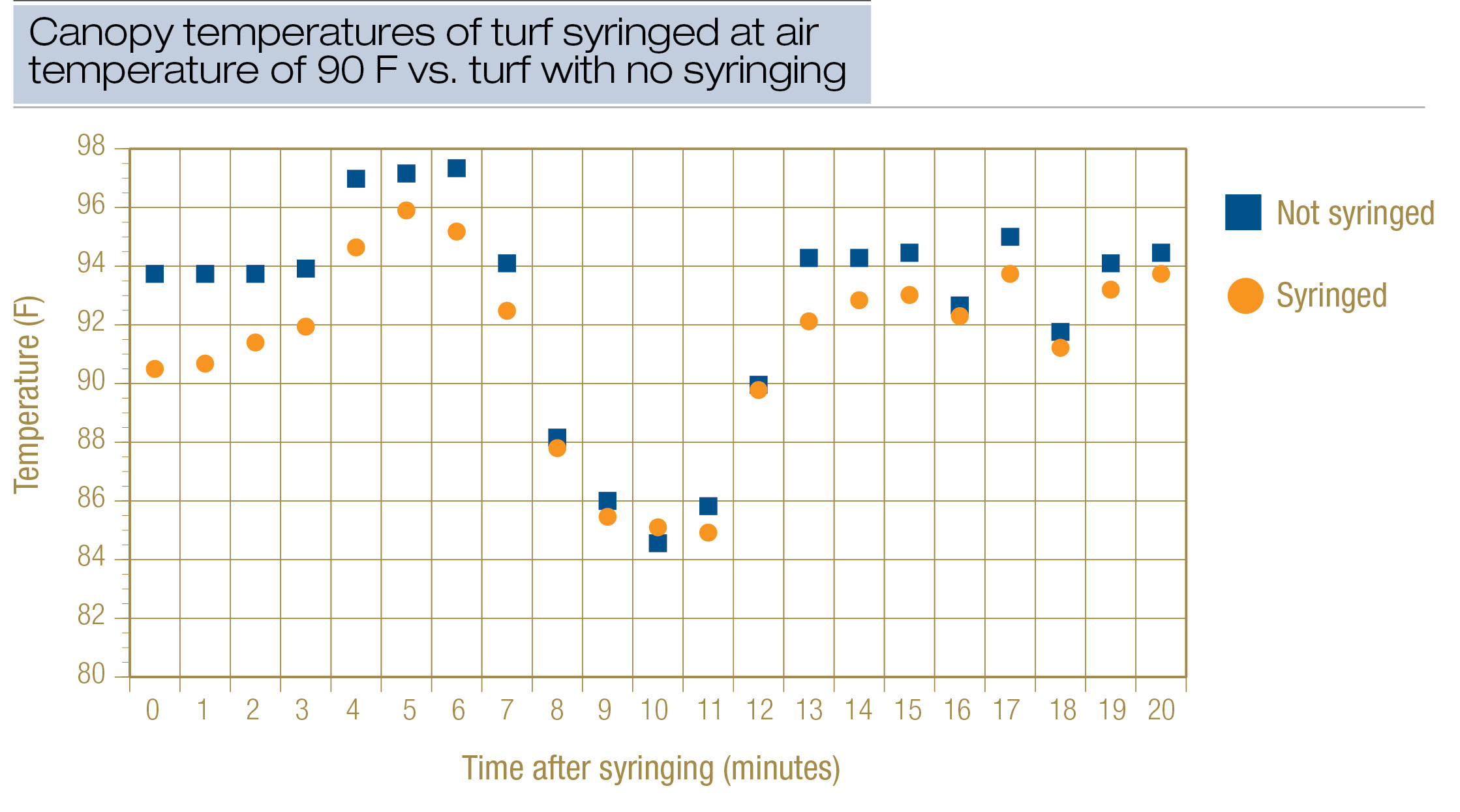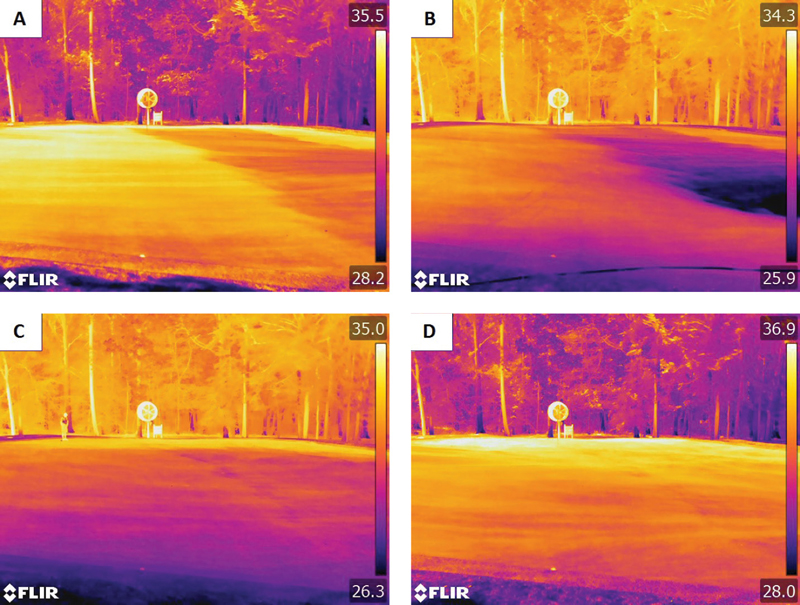
Canopy temperatures of a bentgrass putting green before syringing (A) and at one minute (B), 15 minutes (C) and 20 minutes (D) after syringing when air temperature was at 85 F in August 2016. This is a native (push-up) putting green in Colts Neck, N.J. Photos by Patrick Burgess
High temperature is a primary factor limiting the growth of cool-season turfgrasses. One of the main contributing factors of heat stress is closure of the stomata (apertures on the leaf surface), which otherwise allow carbon dioxide (CO2) influx for photosynthesis and water efflux for transpirational cooling. Prolonged stomatal closure can elevate internal leaf temperature, further intensifying heat damage to plant tissue during hot summer days. Golf putting greens are especially susceptible to excessive heat accumulation during summer, because low mowing heights expose the turf and soil to more solar radiation and further jeopardize the physiological health of the turf. Various management practices, such as syringing, are used to prevent or minimize heat stress damage on putting greens during summer.
Syringing on the golf course
Syringing involves applying a small volume of water (for example, mist) to moisten the uppermost region of the turfgrass canopy, with the intention of promoting evaporative cooling and reducing leaf temperatures. Superintendents commonly invest significant resources in syringing practices by delegating staff members to conduct cyclical rounds of syringing across multiple golf greens during hours of peak sunshine in summer.
Does syringing cool plants?
A quick search of the internet supplies staff testimonials and industry articles supporting the practice of golf turf syringing, including recommendations by United States Golf Association agronomists and university Extension specialists (3). However, applied research that quantifies the effectiveness of syringing for turf canopy cooling and the duration of beneficial cooling effects is limited.
An early study (2) found that syringing reduced the canopy temperature of a creeping bentgrass (Agrostis stolonifera) putting green displaying wilt symptoms by less than 2 F
(-17 C), and that the beneficial cooling effects lasted only 30 minutes after application. In contrast, syringing of non-wilted turf produced no significant cooling effects, regardless of the volume applied or the timing of the application. Twenty years later, scientists at Ohio State University (1) reported that syringing had little effect on canopy cooling beyond 10 minutes after application when practiced on a non-wilted creeping bentgrass turf maintained at fairway height. Canopy cooling was also most effective when air temperatures were above 88 F (31 C). Another, more recent study found that syringing bentgrass greens between 11:30 a.m. and 3 p.m. resulted in a canopy temperature reduction of 7.2 F (-13 C) immediately after the application, but the cooling effect disappeared within 15 to 30 minutes after syringing (4).
How effective is syringing?
Summarizing published research, the true effectiveness of syringing tends to vary between “non-effective” to “moderately effective” for cooling, and temperatures and durations are variable. Moreover, many factors likely contribute to the variable results, including air and soil temperatures, wind speed and direction, relative humidity, soil type and status (for example, compaction), and physiological conditions of plant tissues. An article published in 2010 (3) quoted a superintendent as saying, “I feel syringing greens is one of the most critical jobs done on a golf course and shouldn’t be left to untrained hands.”
Timing and frequency appear to be the primary factors that determine the cooling effectiveness of turfgrass syringing. In many cases, syringing is performed based on an arbitrary time of day, which implies that the temperature may or may not rise to a detrimental level, or, in some cases, may have already exceeded a level detrimental to turf before the syringing is done. When syringing is performed at the improper time of day or applied too often, excess water may likely increase disease incidence because of prolonged leaf and thatch wetness.
Syringing turfgrass: How often, how long and at what temperature?
We conducted research trials on creeping bentgrass putting greens in 2015 and 2016, with an aim to determine the air temperatures at which syringing should be initiated, how long cooling effects may last, and how often syringing should take place.
The trials were conducted on bentgrass putting greens at Hominy Hill Golf Course in Colts Neck, N.J. Syringing treatments were applied during August of each year at an approximate rate of 0.03 to 0.05 inch (0.8 -1.3 mm) of water per treatment when the ambient air temperature reached 85 F (29 C) or 90 F (32 C). Reapplications were made every hour. Data were collected from thermal images using an FLIR thermal imaging infrared thermal camera on days when air temperatures reached 85 F and 90 F, which marked the highest temperatures in the day. All plots that received syringing treatments were compared with untreated plots that were not syringed.

Figure 1. Comparison of canopy temperature of non-syringed turf with turf syringed when air temperature increased to 85 F.

Figure 2. Comparison of canopy temperatures of non-syringed turf with turf syringed when air temperature increased to 90 F.
Air temperatures
Syringing when air temperatures reached 85 F and 90 F reduced canopy temperatures by 6 F to 10 F (-14 C to -12 C) in 2015 and by 4 F to 11 F (-16 C to -12 C) in 2016 compared with plots that were not syringed. On a typical August day, the air temperature reached 85 F around 11 a.m., and the syringing treatment reduced canopy temperatures by 4 F in 2016 (Figure 1, above). When air temperature increased to 90 F by 2 p.m., the canopy temperature decreased by 6 F after syringing treatment in 2016 (Figure 2, above). When syringing was repeated at 3 p.m. and 4 p.m., canopy temperature was reduced by 6 F in both years.
Wind speed
Wind currents affected canopy cooling rates similarly in both trials. In 2016, evaporative cooling effects on canopies lasted 10 to 15 minutes or less when wind speeds were 10 to 15 mph (16-24 kph). When wind speeds were around 5 to 10 mph, cooling effects lasted up to 15 minutes, but cooling effects were less drastic. In 2015, wind speeds did not exceed 10 mph, and when winds were 5 to 10 mph (8-16 kph), the cooling effects also lasted for 10 to 15 minutes. When winds were calm (<5 mph) in both years, the cooling effects lasted from 15 to 20 minutes.
In 2015, duration of canopy temperature reduction was similar for syringed and non-syringed areas of a native (push-up) green and for a green built to USGA recommendations that was tested before syringing. These results indicate that cooling effects may not be based on whether the site is native soil or sand-based.

Canopy temperatures of a bentgrass putting green before syringing (A) and at one minute (B), 15 minutes (C) and 20 minutes (D) after syringing when air temperature was at 90 F in August 2016. This is a native (push-up) putting green in Colts Neck, N.J.
Soil moisture
Before syringing on a given day in the 2016 trial, the average soil moisture content of the native soil turf stands ranged from 19% to 20% and declined by 2% to 3% for non-syringed plots. When syringing was applied every hour through the afternoon, soil moisture content increased by 3% to 4%. Syringing frequently (every hour) may not only moisten the turf canopy, but also moisten the soil or root zone.
Syringing can be effective in reducing canopy temperatures during periods of high temperature stress, but the level and duration of canopy cooling effects varied with wind speed and soil moisture content. When wind speed was higher (10-15 mph), cooling effects of syringing were more pronounced but did not last as long as they did when wind speed was lower (5-10 mph). Using a fan in conjunction with syringing can cool the turf canopy more than syringing alone, producing effects similar to those of wind movement. In addition, syringing should be applied multiple times throughout the hottest period of the day.
Conclusions
Our research suggests that syringing can be effective for canopy cooling of bentgrass putting greens if syringing begins in late morning when the air temperature increases to 85 F and then is applied hourly in the afternoon. It is important, however, to note that hourly syringing may lead to increases in canopy and soil moisture, and moist turf and soils are prone to disease infection. Many pathogens commonly detected in summer are most progressive when temperatures are high and soil moisture is ample. Syringing on drier soils or days can be more effective than under moist or humid conditions. Before deciding to syringe, superintendents should check leaves for signs of wilting or consider measuring soil moisture content.
With careful management, syringing can be a useful practice for cooling the turf canopy to mitigate heat damage when temperatures are elevated to harmful levels. However, scientists have yet to determine whether the short-term cooling (15-20 minutes) of turf leaves resulting from syringing has any physiological benefits — such as promoting photosynthesis — that would promote turfgrass plant health.
Funding
This research was carried out with generous support from the Tri-State Turf Research Foundation.
The research says ...
- Research in 2015 and 2016 found that syringing can reduce turf canopy temperatures, but wind speed and soil moisture content can affect the duration of the effects of syringing.
- Cooling effects of syringing were greater when wind speeds were higher (10-15 mph), and were less pronounced when wind speed was lower (5-10 mph).
- Using a fan plus syringing produces better results than syringing alone, and syringing several times in the heat of the day is necessary.
- Hourly syringing can result in excessive soil moisture, which can lead to disease infection. Syringing on drier soils or less-humid days can be more effective.
Literature cited
- Danneberger, K., and D. Gardner. 2004. Syringing can dramatically affect canopy temperature. Turfgrass Trends (in Golfdom) (6):63-64. (http://archive.lib.msu.edu/tic/golfd/article/2004jun63.pdf) Accessed Feb. 22, 2018.
- DiPaola, J.M. 1984. Syringing effects on the canopy temperatures of bentgrass greens. Agronomy Journal 76:951-953. doi:10.2134/agronj1984.00021962007600060020x
- McPherson, D. 2010. Turf maintenance: A good cooling. Golf Course Industry. (www.golfcourseindustry.com/article/gci-0310-turf-maintenance-syringing) Accessed Feb. 22, 2018.
- Peacock, C.H., B.W. Bennett Jr., and A.H. Bruneau. 2002. Effects of syringing on summer stress performance of creeping bentgrass (Agrostis stolonifera L.). Pages 610-619. In: Eric Thain, ed. Science and Golf IV: Proceedings of the World Scientific Congress of Golf. Routledge, London.
Bingru Huang is a Distinguished Professor, Stephanie Rossi is a laboratory researcher, and Patrick Burgess, currently employed by Bayer Turf & Ornamentals, was a researcher in the Department of Plant Biology, Rutgers University, New Brunswick, N.J.